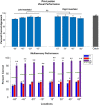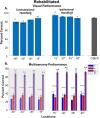Cross-modal exposure restores multisensory enhancement after hemianopia
- PMID: 37724427
- PMCID: PMC10646694
- DOI: 10.1093/cercor/bhad343
Cross-modal exposure restores multisensory enhancement after hemianopia
Abstract
Hemianopia is a common consequence of unilateral damage to visual cortex that manifests as a profound blindness in contralesional space. A noninvasive cross-modal (visual-auditory) exposure paradigm has been developed in an animal model to ameliorate this disorder. Repeated stimulation of a visual-auditory stimulus restores overt responses to visual stimuli in the blinded hemifield. It is believed to accomplish this by enhancing the visual sensitivity of circuits remaining after a lesion of visual cortex; in particular, circuits involving the multisensory neurons of the superior colliculus. Neurons in this midbrain structure are known to integrate spatiotemporally congruent visual and auditory signals to amplify their responses, which, in turn, enhances behavioral performance. Here we evaluated the relationship between the rehabilitation of hemianopia and this process of multisensory integration. Induction of hemianopia also eliminated multisensory enhancement in the blinded hemifield. Both vision and multisensory enhancement rapidly recovered with the rehabilitative cross-modal exposures. However, although both reached pre-lesion levels at similar rates, they did so with different spatial patterns. The results suggest that the capability for multisensory integration and enhancement is not a pre-requisite for visual recovery in hemianopia, and that the underlying mechanisms for recovery may be more complex than currently appreciated.
Keywords: hemianopia; multisensory integration; rehabilitation; vision.
© The Author(s) 2023. Published by Oxford University Press. All rights reserved. For permissions, please e-mail: journals.permissions@oup.com.
Figures





References
-
- Bell AH, Corneil BD, Meredith MA, Munoz DP. The influence of stimulus properties on multisensory processing in the awake primate superior colliculus. Can J Exp Psychol Rev Can Psychol Expérimentale. 2001:55(2):123–132. - PubMed
-
- Benedetti F. Orienting behaviour and superior colliculus sensory representations in mice with the vibrissae bent into the contralateral hemispace. Eur J Neurosci. 1995:7(7):1512–1519. - PubMed
-
- Burnett LR, Stein BE, Chaponis D, Wallace MT. Superior colliculus lesions preferentially disrupt multisensory orientation. Neuroscience. 2004:124(3):535–547. - PubMed
Publication types
MeSH terms
Grants and funding
LinkOut - more resources
Full Text Sources

